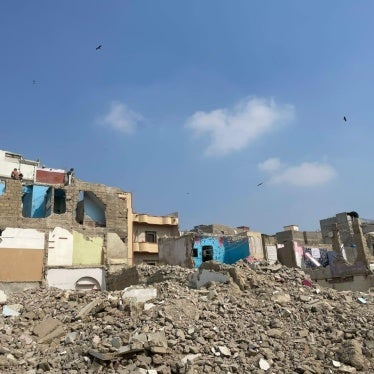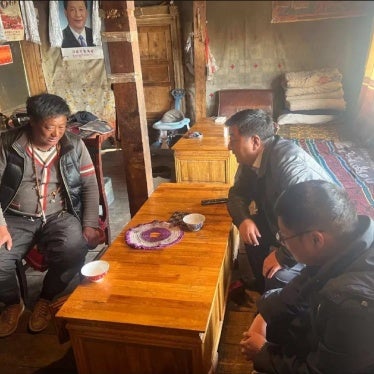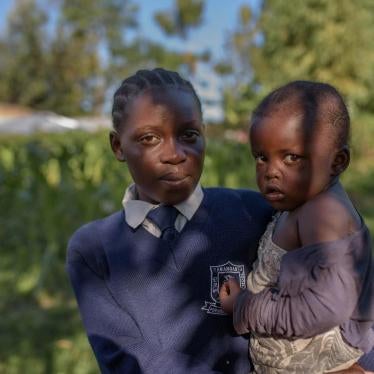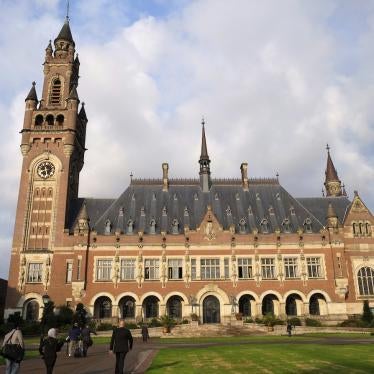(New York) – Numerous high-level officials and advisors in Afghanistan’s current government are implicated in major war crimes and human rights abuses that took place in the early 1990s, Human Rights Watch said in a new report released today.
The 133-page report, “Blood-Stained Hands: Past Atrocities in Kabul and Afghanistan’s Legacy of Impunity,” is based on extensive research by Human Rights Watch over the last two years, including more than 150 interviews with witnesses,n survivors, government officials, and combatants. It documents war crimes and human rights abuses during a particularly bloody year in Afghanistan’s civil war—the Afghan calendar year of 1371, from April 1992 to March 1993, following the collapse of the Soviet-backed Najibullah government in Kabul.
Human Rights Watch said that although some perpetrators are dead or currently in hiding, many leaders implicated in the abuses are now officials in Afghanistan’s defense or interior ministries, or are advisors to President Hamid Karzai. Some are running for office in parliamentary and local elections scheduled for September 2005. Others operate as warlords or regional strongmen, directing subordinates in official positions.
“This report isn’t just a history lesson,” said Brad Adams, executive director of the Asia Division of Human Rights Watch. “These atrocities were among some of the gravest in Afghanistan’s history, yet today many of the perpetrators still wield power.”
The period covered in the report, the Afghan year 1371, was marked by intense fighting in Kabul between different mujahedeen and former government factions vying for power in the wake of the government’s collapse. As the year began, the city was largely unscathed by serious military conflict, but as hostilities progressed, whole sections of Kabul were reduced to rubble, tens of thousands of civilians were killed and wounded, and at least half a million people were displaced.
Rival armed factions committed extensive human rights abuses and violations of the laws of war, illegally shelling and rocketing civilian areas, abducting and murdering civilians, and pillaging civilian areas. The report shows that the abuses of the period were neither inevitable consequences of war nor unavoidable mistakes, but were rather the results of illegal acts and omissions by factional leaders and commanders. The report notes that many commanders may be criminally culpable for their behavior during this period.
Human Rights Watch urged the Afghan government and international community to prioritize efforts to hold past perpetrators accountable for their crimes by creating a Special Court to try offenders.
“Perpetrators of past abuses who go unpunished are more likely to commit new abuses and use violence to get their way,” said Adams. “They pose a continuing threat to Afghanistan’s future.”
To help maintain independence and guarantee international fair trial standards, Human Rights Watch recommended that the court be comprised of both Afghan and international judges, with an international majority, and with an international prosecutor.
As judicial reform is a necessary precursor for any meaningful attempts to provide justice for past abuses, Human Rights Watch also urged the government to accelerate and redouble efforts to reform the judicial system and establish an independent judiciary.
Human Rights Watch also called on the government to implement vetting mechanisms to sideline past abusers from government.
Many Afghans, especially in Kabul, have terrible memories of the fighting in the early 1990s. An Afghan witness described an incident in which factional forces targeted civilians from one of Kabul’s central mountains: “They were firing into this street. . . . Seventeen people were killed. . . . Clearly they were civilians. Yes, it was clear: they had burqas, there were children.”
An Afghan nurse quoted in the report described the typical effects of street fighting: “Hundreds of people were wounded when they fought—every time they fought. The hospital would be full of patients, overwhelmed; we couldn’t treat everyone who was brought there. People were dying in the halls.”
Human Rights Watch said that much of Afghanistan’s last 27 years has been marked by human rights abuses and violations of the laws of war. Afghanistan suffered 14 years of domination by the Soviet Union from 1978 to 1992, marked by large-scale atrocities by the Soviet Army, carpet bombing of civilian areas, murder and torture of prisoners, and harsh political repression. The Taliban, which ruled from 1996 to 2001, also committed war crimes and other abuses, and as a government operated almost entirely outside of established human rights principles.
“In Afghanistan today, alleged war criminals—Taliban, mujahedeen, communist—enjoy total impunity in the name of national reconciliation,” said Adams. “This is an insult to victims and an affront to justice.”
Human Rights Watch’s report implicates numerous factional leaders and commanders for their role in the abuses, including:
- Abdul Rabb al-Rasul Sayyaf, a radical Islamist commander and leader of the
Ittihad-e Islami faction, who now advises President Karzai and
exercises major political power over the Afghan judiciary and has
numerous proxies within the Afghan government; - Abdul Rashid Dostum, the leader of the Junbish-e Milli faction who now holds
a senior post in the ministry of defense and exercises political
control of several provinces in the north of Afghanistan; - Mohammad Qasim Fahim, Afghanistan’s defense minister from 2001 to 2004 and a
commander in the Jamiat-e Islami/Shura-e Nazar faction of Burhanuddin
Rabbani and Ahmed Shah Massoud (who was killed in 2001); and - Karim Khalili, a commander in the Hezb-e Wahdat faction and now one of President Karzai’s two vice-presidents.
Gulbuddin Hekmatyar, the leader of the Hezb-e Islami faction, which committed some of the worst crimes of the period, is currently at large and is believed to be coordinating insurgent attacks on Afghan and U.S. military forces in Afghanistan.
Human Rights Watch said that several other commanders from the Jamiat-e Islami and Shura-e Nazar faction implicated in crimes
during the early 1990s are now candidates for parliament or are serving in the police and military. Numerous commanders from Sayyaf’s Ittihad faction are also serving in important security and judicial posts.
In addition to proposing a Special Court, the report recommends that the president appoint an expert panel to propose and help implement additional programs to address issues not dealt with by
the Special Court, such as trying crimes outside the Special Court’s jurisdiction; creating an archive for the historical documentation of past abuses; recommending appropriate restitution or compensation mechanisms; and starting educational initiatives, such as the drafting of fair historical accounts for school textbooks.
“If Afghanistan doesn’t begin a process of addressing its history now, the past may repeat itself,” said Adams
Excerpts from Blood-Stained Hands
An account of an artillery attack by Gulbuddin Hekmatyar’s Hezb-e Islami faction against a civilian area in West Kabul, June 1992:
“It was about 4 p.m., and I was baking some bread
outside, over a fire. Suddenly, there was a big explosion. I took
cover, on the ground. Then, there was another explosion. I got up and I
could see this woman here [pointing to a neighbor, who is crying and
nodding], and she was just running about. Her son had been sitting near
this wall outside, where the artillery landed, and he was completely
blown up. This woman here was running about, collecting pieces of [her
son’s] flesh in her apron, and crying. . . . He was completely blown
up, disappeared.”
A witness describing a typical street battle in west Kabul in mid-1992:
“Everything was bullets, it was very severe. Everyone was rushing to flee from the
violence. Husbands forgot wives, brothers forgot sisters, mothers
forgot children, uncles forgot nephews—everyone was running away, and
could only think of safety. . . . I could see the women and men rushing
away from the fighting, running down the street towards us. At the same
time, some of the bullets, or shrapnel from the explosions, was hitting
people. So men and women were falling down into the street. They would
be running, and then the bullets would hit them, and they would fall
down. The other people just kept running, and were not bothering to
save those who fell. They were all rushing to save themselves. It was a
terrible day.”
An Afghan health worker in west Kabul, describing how Ahmed Shah Massoud’s Jamiat-e Islami faction would fire at civilians from the top of “Television Mountain” in the center of Kabul:
“There was a time when the Jamiat troops on TV Mountain
would target anything on Alaudin Street [a main road in west Kabul].
They would target anything that moved, even a cat. . . . I remember
[one time] I went out to go to this clinic [to obtain medical
equipment], and as soon as they saw me on that mountain they were
shooting. Anything that looked like a human being would be targeted.
They shot everything: rockets, shells, bullets. There were times when
the streets were littered with bullets.”
A Pashtun civilian who was abducted in 1992 and imprisoned by the predominantly Pashtun Ittihad-i Islami faction headed by Abdul Rabb al-Rasul Sayyaf:
“Sayyaf’s forces brought thirty or forty Hazara
civilians. . . . They were not fighters, but civilians, old and young.
[Later] the fighting [outside] got severe. We could hear the artillery.
There was a lot of shooting. I could hear these people, Sayyaf’s
people, talking about retreating. And at one point, one of them said to
Commander Tourgal [an Ittihad commander], ‘What should we do with these
prisoners?’
“They were speaking in Pashto, and the
Hazara people couldn’t understand them. But I could understand.
Somebody said, ‘Go and shoot them.’
“I was near the door. When I heard this, I hurried away and hid away from the door, in
the corner of the room [on the side of the room with the door]. A
person came, and opened the door, and shot all over the room with his
Kalashnikov, on automatic. He just fired randomly all over the room.
About ten people were killed, immediately, and four were wounded. . . .
After, no one moved. We [who were still alive] were trembling with
fear.”
A Tajik student who was abducted by Abdul Ali Mazari’s Hezb-e Wahdat faction in 1992:
“[A] commander with two bodyguards came. . . . ‘You both are some guys from
Shomali and you are helping Massoud!’ he said. —I said, ‘I am a medical
student; neither I nor my brother are soldiers. We are from Shomali,
but we are not soldiers.’ —‘Keep quiet,’ he said. And then the guards
cocked their Kalashnikovs. The commander signaled to his troops to take
us away. . . .”
A witness to killings of civilians by Sayyaf’s Ittihad faction in the Afshar neighborhood in West Kabul, February 1993:
“Najaf Karbalie, an old man, had come out of his house, and they had separated
him from his family to arrest him. As this happened, his wife came to
him and grabbed him and was pulling on him, saying, ‘Please, leave him,
he is old. Leave him.’ But the gunmen did not let go of him. . . .And
the gunmen started beating him. They were also beating someone else,
next to him.
“Karbalie’s wife and another woman threw themselves on them, their husbands, and were yelling at the
troops, insulting them. The troops grabbed the one woman, and then the
other, pushed them off the men, and then threw them on the ground and
killed them.
“They took their guns, with the bayonets, and stabbed the women as they lay on the ground, stabbed them
many times over, at least ten times. We all saw of this. After, the
women were lying on the ground. They were shaking at first; their feet
were twitching. They were dead. The two men, both of them, fainted.
They were unconscious. The women were about thirty-five, or forty. I
think that one of them was pregnant. She looked pregnant. . . .”
A Kabul resident, describing a summary execution of a civilian by a soldier with the Harakat-e Islami faction in September 1992:
“I had [a store] in front of my house. I was selling some things there,
one morning, sitting there. I saw this younger guy walk by—he had
recently been married. Then I heard some shooting down the street. I
looked down the street, and I saw that the guy who had passed was on
the ground, and this other guy was over him—he held a pistol up to his
head and shot him in the temple. The guy was dead. Some other people on
the street walked a little forward [toward the body], and then stopped.
. . . This gunman, he was a Harakat gunman, just walked by us, slowly.
Like he could do whatever he wanted. We saw him clearly. We knew who he
was—he was a Harakat man.”
A correspondent with the British Broadcasting Corporation, who witnessed looting and violence committed by Abdul Rashid Dostum’s Junbish-e Milli faction:
“Junbish had been looting. . . . We filmed Junbish
troops beating up this guy who had a bicycle. I guess they wanted to
take the bicycle. . . . They were clubbing him with Kalashnikovs, but
when one of the troops saw us and pointed at us, they sent the guy on
his way. [In another case,] Uzbek troops [Junbish] saw us, and they
were acting up for the camera. They had this guy, this civilian, and
they wanted to show off. They were making him stand a few meters away
and they were shooting at his feet with their Kalashnikovs, making him
dance. They were yelling, ‘Dance! Dance!’ and shooting at his feet.”






